Ethical Change Management: Analysis of Lakeland Wonders Report
VerifiedAdded on 2023/06/03
|6
|1449
|105
Report
AI Summary
This report delves into the realm of ethical change management, focusing on the practical application of principles within the context of the Lakeland Wonders case. It emphasizes the importance of transparency in decision-making processes and the implementation of fair benchmarking to mitigate employee unrest during organizational changes. The report analyzes the challenges faced by organizations during transitions, such as improper decision-making and the need for clear communication of objectives. It presents a scenario involving Kids & Company, highlighting the resistance to change and proposes strategies like employee performance reviews and the introduction of external consultants to address these challenges. The report concludes by emphasizing the significance of ethical frameworks in facilitating smoother and more effective change management processes.
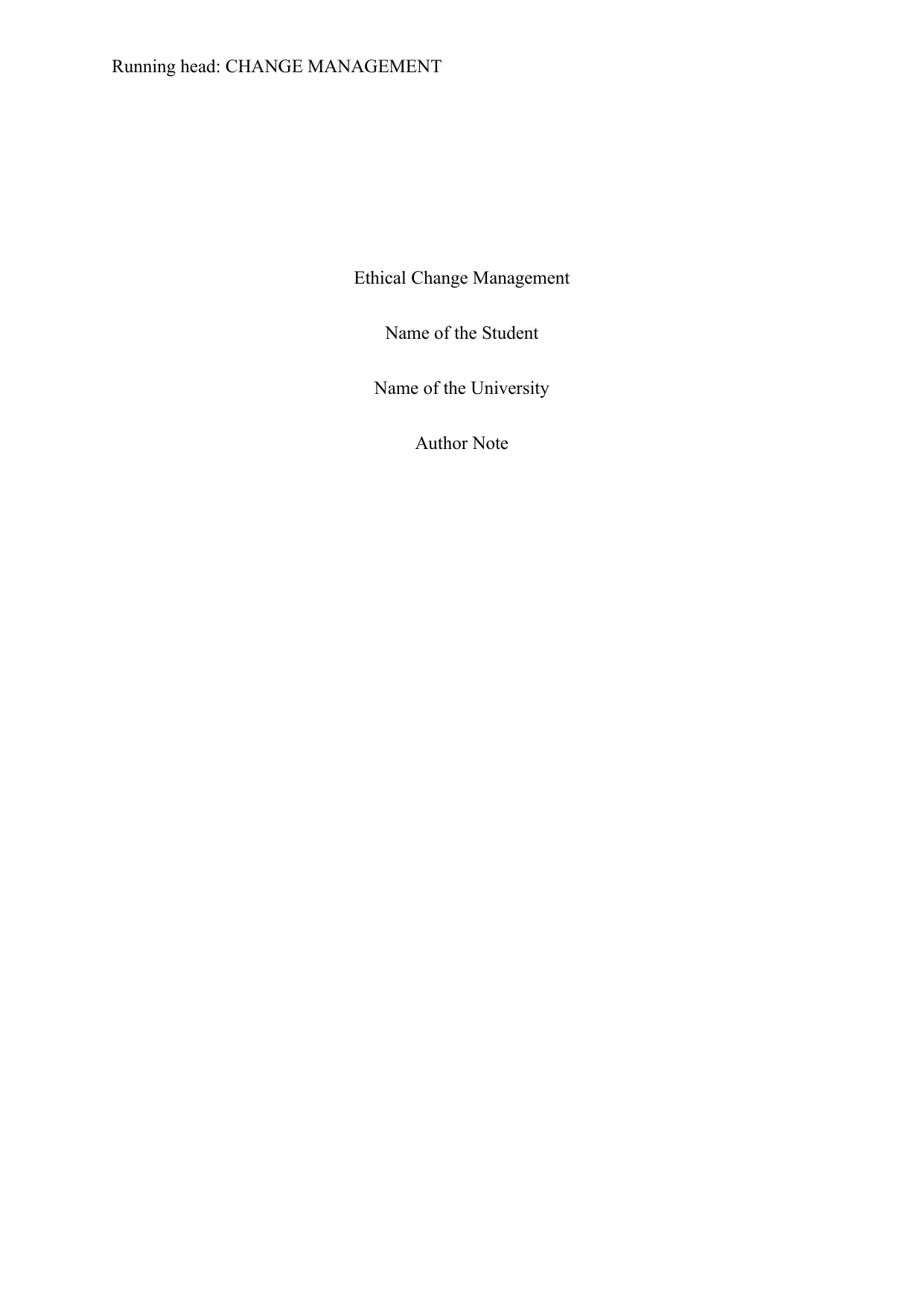
Running head: CHANGE MANAGEMENT
Ethical Change Management
Name of the Student
Name of the University
Author Note
Ethical Change Management
Name of the Student
Name of the University
Author Note
Paraphrase This Document
Need a fresh take? Get an instant paraphrase of this document with our AI Paraphraser
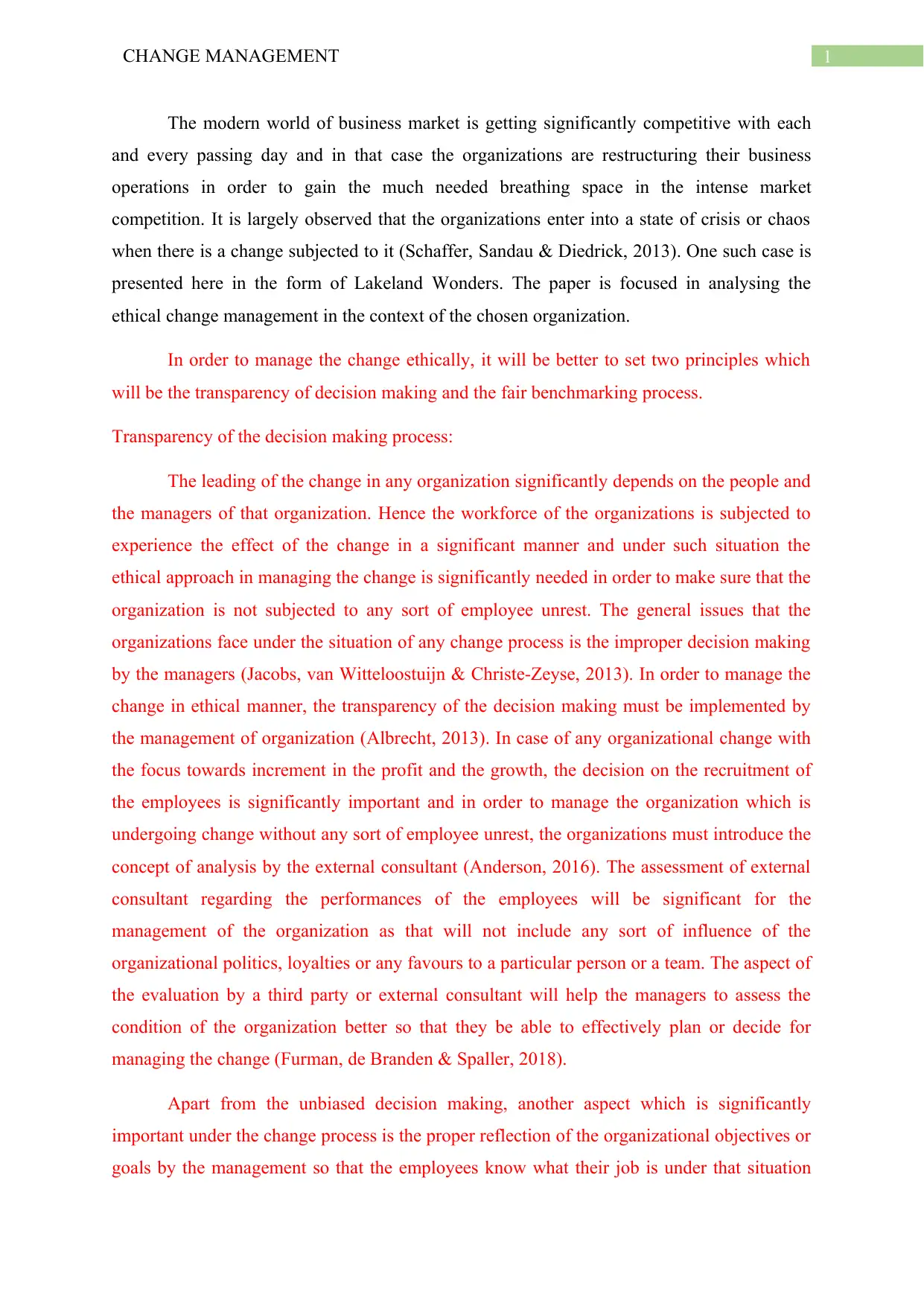
1CHANGE MANAGEMENT
The modern world of business market is getting significantly competitive with each
and every passing day and in that case the organizations are restructuring their business
operations in order to gain the much needed breathing space in the intense market
competition. It is largely observed that the organizations enter into a state of crisis or chaos
when there is a change subjected to it (Schaffer, Sandau & Diedrick, 2013). One such case is
presented here in the form of Lakeland Wonders. The paper is focused in analysing the
ethical change management in the context of the chosen organization.
In order to manage the change ethically, it will be better to set two principles which
will be the transparency of decision making and the fair benchmarking process.
Transparency of the decision making process:
The leading of the change in any organization significantly depends on the people and
the managers of that organization. Hence the workforce of the organizations is subjected to
experience the effect of the change in a significant manner and under such situation the
ethical approach in managing the change is significantly needed in order to make sure that the
organization is not subjected to any sort of employee unrest. The general issues that the
organizations face under the situation of any change process is the improper decision making
by the managers (Jacobs, van Witteloostuijn & Christe-Zeyse, 2013). In order to manage the
change in ethical manner, the transparency of the decision making must be implemented by
the management of organization (Albrecht, 2013). In case of any organizational change with
the focus towards increment in the profit and the growth, the decision on the recruitment of
the employees is significantly important and in order to manage the organization which is
undergoing change without any sort of employee unrest, the organizations must introduce the
concept of analysis by the external consultant (Anderson, 2016). The assessment of external
consultant regarding the performances of the employees will be significant for the
management of the organization as that will not include any sort of influence of the
organizational politics, loyalties or any favours to a particular person or a team. The aspect of
the evaluation by a third party or external consultant will help the managers to assess the
condition of the organization better so that they be able to effectively plan or decide for
managing the change (Furman, de Branden & Spaller, 2018).
Apart from the unbiased decision making, another aspect which is significantly
important under the change process is the proper reflection of the organizational objectives or
goals by the management so that the employees know what their job is under that situation
The modern world of business market is getting significantly competitive with each
and every passing day and in that case the organizations are restructuring their business
operations in order to gain the much needed breathing space in the intense market
competition. It is largely observed that the organizations enter into a state of crisis or chaos
when there is a change subjected to it (Schaffer, Sandau & Diedrick, 2013). One such case is
presented here in the form of Lakeland Wonders. The paper is focused in analysing the
ethical change management in the context of the chosen organization.
In order to manage the change ethically, it will be better to set two principles which
will be the transparency of decision making and the fair benchmarking process.
Transparency of the decision making process:
The leading of the change in any organization significantly depends on the people and
the managers of that organization. Hence the workforce of the organizations is subjected to
experience the effect of the change in a significant manner and under such situation the
ethical approach in managing the change is significantly needed in order to make sure that the
organization is not subjected to any sort of employee unrest. The general issues that the
organizations face under the situation of any change process is the improper decision making
by the managers (Jacobs, van Witteloostuijn & Christe-Zeyse, 2013). In order to manage the
change in ethical manner, the transparency of the decision making must be implemented by
the management of organization (Albrecht, 2013). In case of any organizational change with
the focus towards increment in the profit and the growth, the decision on the recruitment of
the employees is significantly important and in order to manage the organization which is
undergoing change without any sort of employee unrest, the organizations must introduce the
concept of analysis by the external consultant (Anderson, 2016). The assessment of external
consultant regarding the performances of the employees will be significant for the
management of the organization as that will not include any sort of influence of the
organizational politics, loyalties or any favours to a particular person or a team. The aspect of
the evaluation by a third party or external consultant will help the managers to assess the
condition of the organization better so that they be able to effectively plan or decide for
managing the change (Furman, de Branden & Spaller, 2018).
Apart from the unbiased decision making, another aspect which is significantly
important under the change process is the proper reflection of the organizational objectives or
goals by the management so that the employees know what their job is under that situation
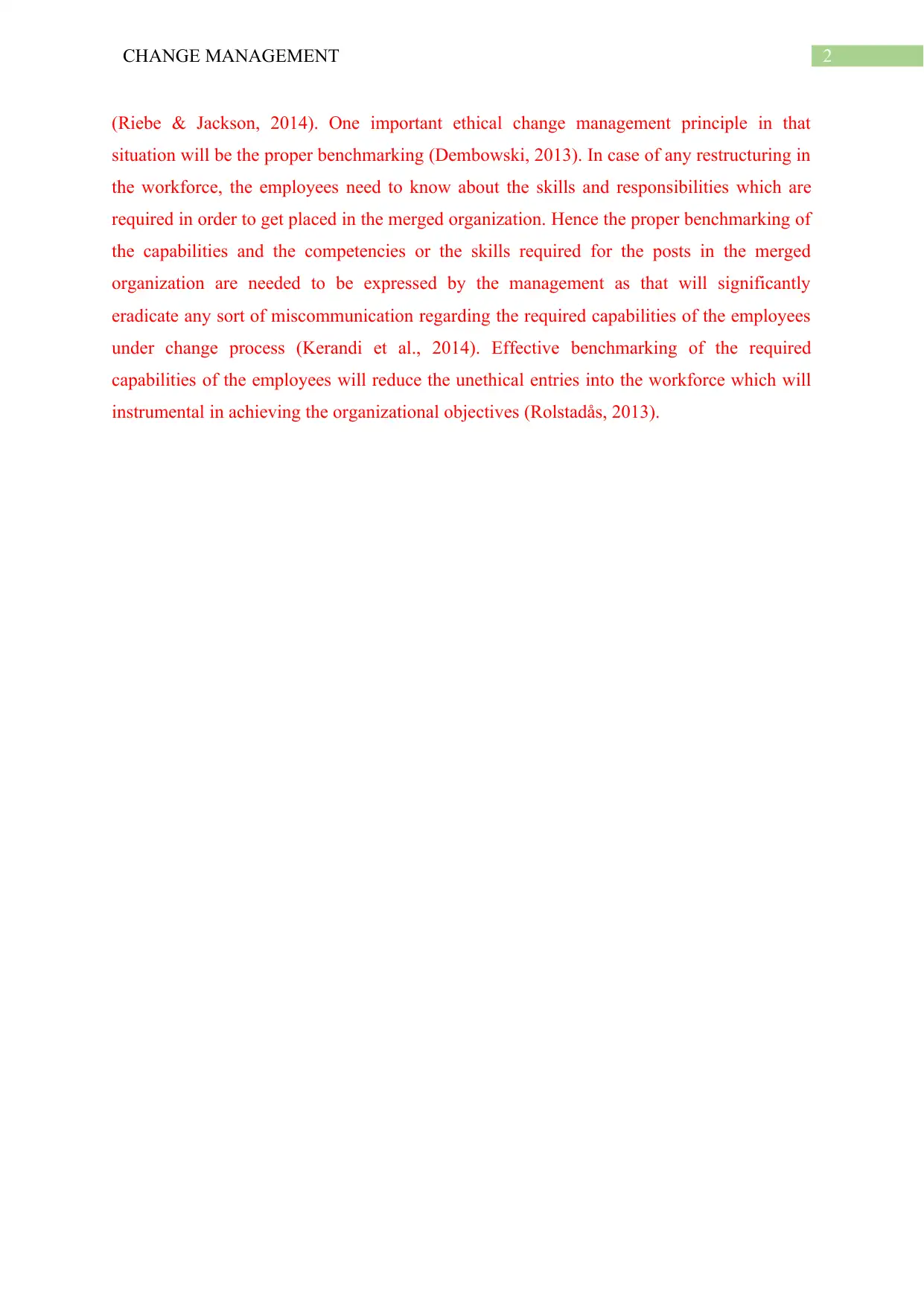
2CHANGE MANAGEMENT
(Riebe & Jackson, 2014). One important ethical change management principle in that
situation will be the proper benchmarking (Dembowski, 2013). In case of any restructuring in
the workforce, the employees need to know about the skills and responsibilities which are
required in order to get placed in the merged organization. Hence the proper benchmarking of
the capabilities and the competencies or the skills required for the posts in the merged
organization are needed to be expressed by the management as that will significantly
eradicate any sort of miscommunication regarding the required capabilities of the employees
under change process (Kerandi et al., 2014). Effective benchmarking of the required
capabilities of the employees will reduce the unethical entries into the workforce which will
instrumental in achieving the organizational objectives (Rolstadås, 2013).
(Riebe & Jackson, 2014). One important ethical change management principle in that
situation will be the proper benchmarking (Dembowski, 2013). In case of any restructuring in
the workforce, the employees need to know about the skills and responsibilities which are
required in order to get placed in the merged organization. Hence the proper benchmarking of
the capabilities and the competencies or the skills required for the posts in the merged
organization are needed to be expressed by the management as that will significantly
eradicate any sort of miscommunication regarding the required capabilities of the employees
under change process (Kerandi et al., 2014). Effective benchmarking of the required
capabilities of the employees will reduce the unethical entries into the workforce which will
instrumental in achieving the organizational objectives (Rolstadås, 2013).
⊘ This is a preview!⊘
Do you want full access?
Subscribe today to unlock all pages.

Trusted by 1+ million students worldwide
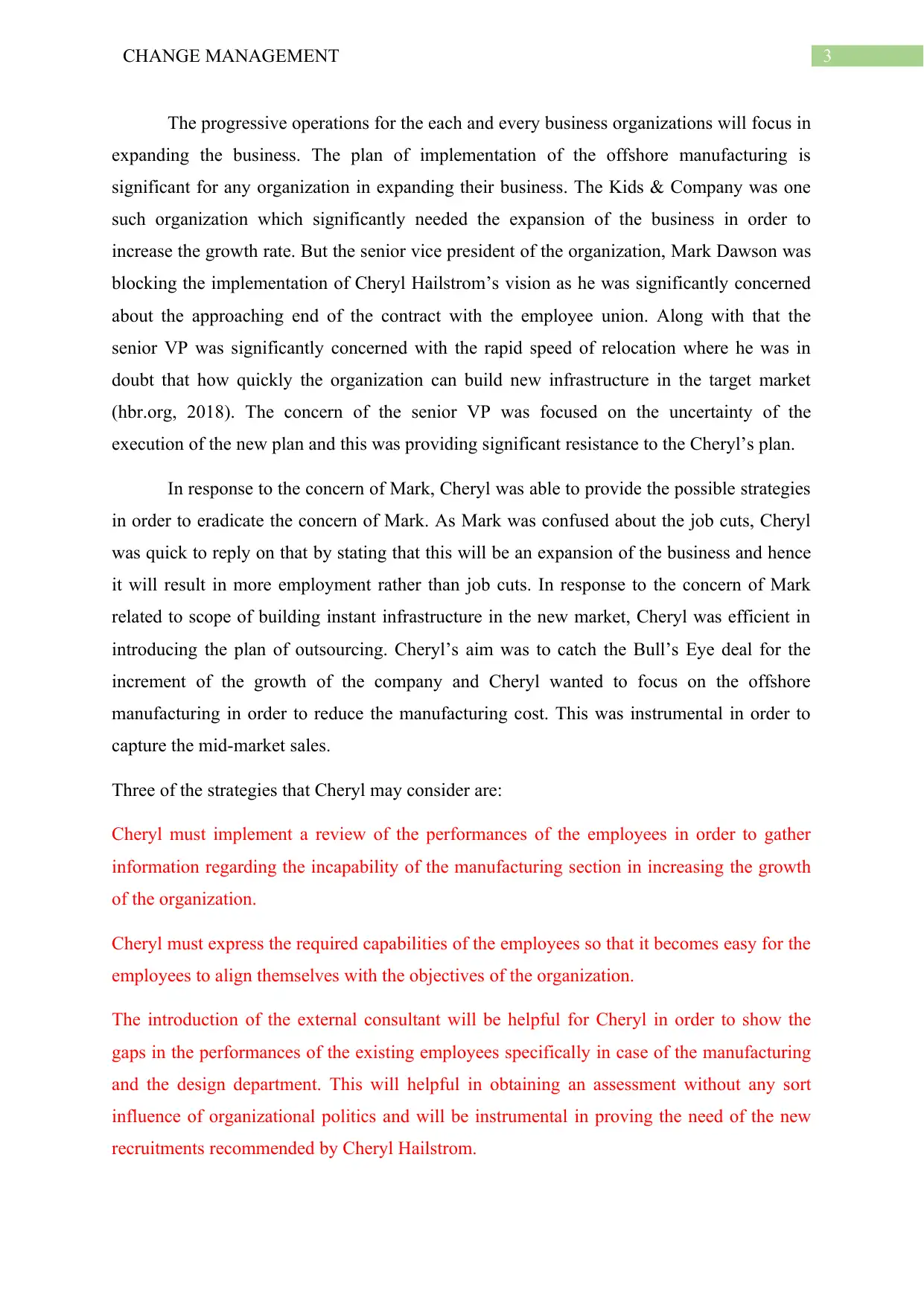
3CHANGE MANAGEMENT
The progressive operations for the each and every business organizations will focus in
expanding the business. The plan of implementation of the offshore manufacturing is
significant for any organization in expanding their business. The Kids & Company was one
such organization which significantly needed the expansion of the business in order to
increase the growth rate. But the senior vice president of the organization, Mark Dawson was
blocking the implementation of Cheryl Hailstrom’s vision as he was significantly concerned
about the approaching end of the contract with the employee union. Along with that the
senior VP was significantly concerned with the rapid speed of relocation where he was in
doubt that how quickly the organization can build new infrastructure in the target market
(hbr.org, 2018). The concern of the senior VP was focused on the uncertainty of the
execution of the new plan and this was providing significant resistance to the Cheryl’s plan.
In response to the concern of Mark, Cheryl was able to provide the possible strategies
in order to eradicate the concern of Mark. As Mark was confused about the job cuts, Cheryl
was quick to reply on that by stating that this will be an expansion of the business and hence
it will result in more employment rather than job cuts. In response to the concern of Mark
related to scope of building instant infrastructure in the new market, Cheryl was efficient in
introducing the plan of outsourcing. Cheryl’s aim was to catch the Bull’s Eye deal for the
increment of the growth of the company and Cheryl wanted to focus on the offshore
manufacturing in order to reduce the manufacturing cost. This was instrumental in order to
capture the mid-market sales.
Three of the strategies that Cheryl may consider are:
Cheryl must implement a review of the performances of the employees in order to gather
information regarding the incapability of the manufacturing section in increasing the growth
of the organization.
Cheryl must express the required capabilities of the employees so that it becomes easy for the
employees to align themselves with the objectives of the organization.
The introduction of the external consultant will be helpful for Cheryl in order to show the
gaps in the performances of the existing employees specifically in case of the manufacturing
and the design department. This will helpful in obtaining an assessment without any sort
influence of organizational politics and will be instrumental in proving the need of the new
recruitments recommended by Cheryl Hailstrom.
The progressive operations for the each and every business organizations will focus in
expanding the business. The plan of implementation of the offshore manufacturing is
significant for any organization in expanding their business. The Kids & Company was one
such organization which significantly needed the expansion of the business in order to
increase the growth rate. But the senior vice president of the organization, Mark Dawson was
blocking the implementation of Cheryl Hailstrom’s vision as he was significantly concerned
about the approaching end of the contract with the employee union. Along with that the
senior VP was significantly concerned with the rapid speed of relocation where he was in
doubt that how quickly the organization can build new infrastructure in the target market
(hbr.org, 2018). The concern of the senior VP was focused on the uncertainty of the
execution of the new plan and this was providing significant resistance to the Cheryl’s plan.
In response to the concern of Mark, Cheryl was able to provide the possible strategies
in order to eradicate the concern of Mark. As Mark was confused about the job cuts, Cheryl
was quick to reply on that by stating that this will be an expansion of the business and hence
it will result in more employment rather than job cuts. In response to the concern of Mark
related to scope of building instant infrastructure in the new market, Cheryl was efficient in
introducing the plan of outsourcing. Cheryl’s aim was to catch the Bull’s Eye deal for the
increment of the growth of the company and Cheryl wanted to focus on the offshore
manufacturing in order to reduce the manufacturing cost. This was instrumental in order to
capture the mid-market sales.
Three of the strategies that Cheryl may consider are:
Cheryl must implement a review of the performances of the employees in order to gather
information regarding the incapability of the manufacturing section in increasing the growth
of the organization.
Cheryl must express the required capabilities of the employees so that it becomes easy for the
employees to align themselves with the objectives of the organization.
The introduction of the external consultant will be helpful for Cheryl in order to show the
gaps in the performances of the existing employees specifically in case of the manufacturing
and the design department. This will helpful in obtaining an assessment without any sort
influence of organizational politics and will be instrumental in proving the need of the new
recruitments recommended by Cheryl Hailstrom.
Paraphrase This Document
Need a fresh take? Get an instant paraphrase of this document with our AI Paraphraser
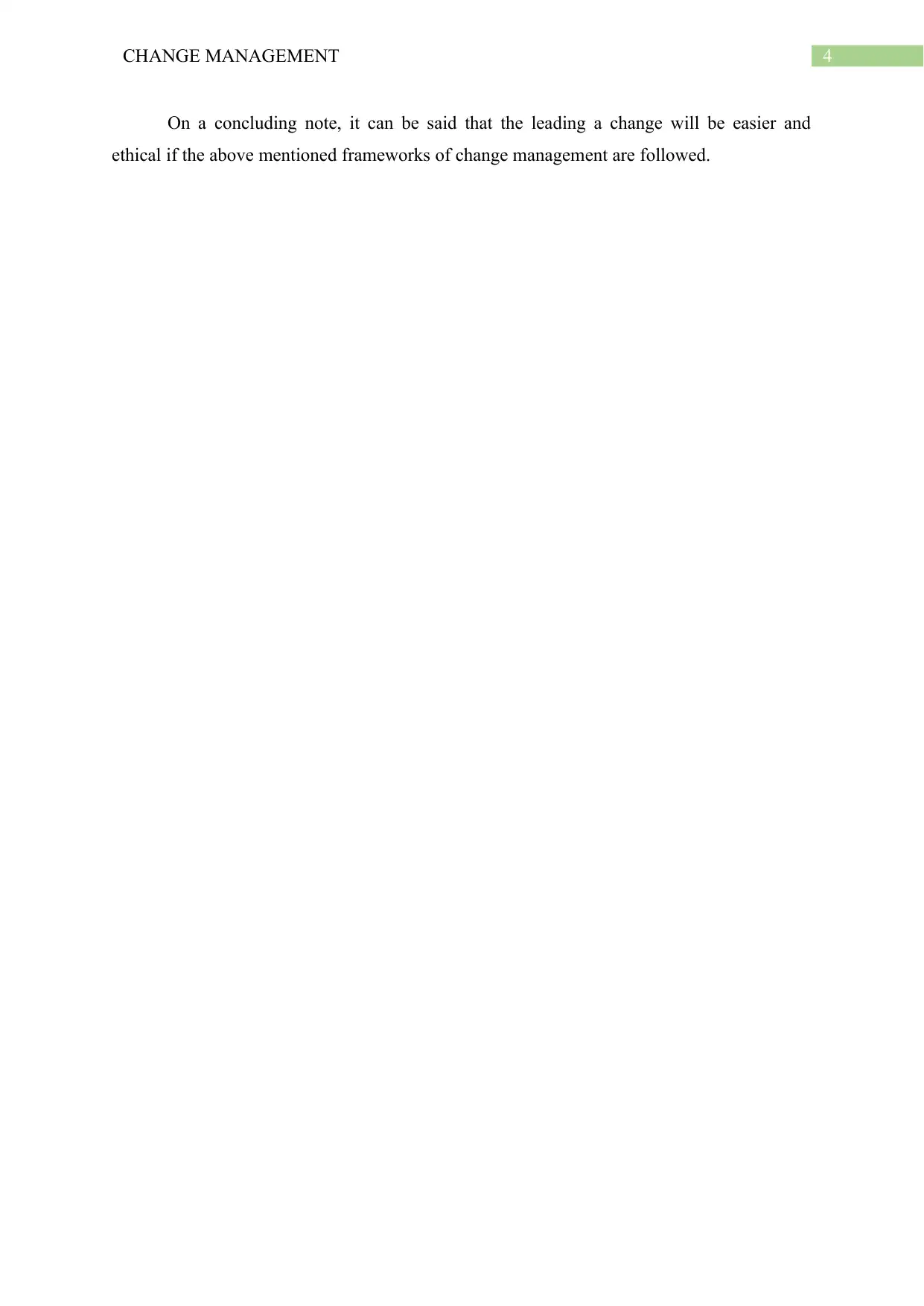
4CHANGE MANAGEMENT
On a concluding note, it can be said that the leading a change will be easier and
ethical if the above mentioned frameworks of change management are followed.
On a concluding note, it can be said that the leading a change will be easier and
ethical if the above mentioned frameworks of change management are followed.
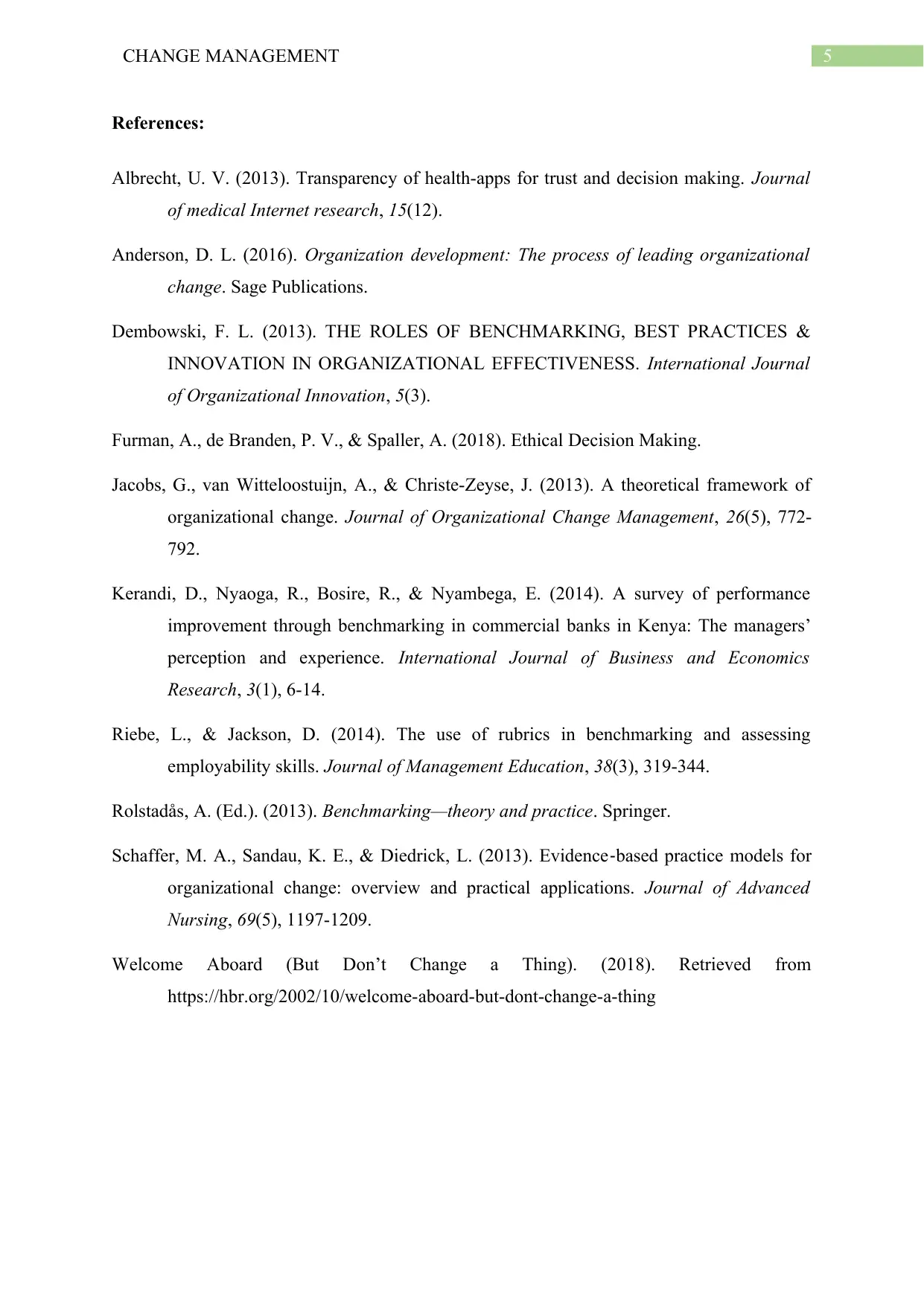
5CHANGE MANAGEMENT
References:
Albrecht, U. V. (2013). Transparency of health-apps for trust and decision making. Journal
of medical Internet research, 15(12).
Anderson, D. L. (2016). Organization development: The process of leading organizational
change. Sage Publications.
Dembowski, F. L. (2013). THE ROLES OF BENCHMARKING, BEST PRACTICES &
INNOVATION IN ORGANIZATIONAL EFFECTIVENESS. International Journal
of Organizational Innovation, 5(3).
Furman, A., de Branden, P. V., & Spaller, A. (2018). Ethical Decision Making.
Jacobs, G., van Witteloostuijn, A., & Christe-Zeyse, J. (2013). A theoretical framework of
organizational change. Journal of Organizational Change Management, 26(5), 772-
792.
Kerandi, D., Nyaoga, R., Bosire, R., & Nyambega, E. (2014). A survey of performance
improvement through benchmarking in commercial banks in Kenya: The managers’
perception and experience. International Journal of Business and Economics
Research, 3(1), 6-14.
Riebe, L., & Jackson, D. (2014). The use of rubrics in benchmarking and assessing
employability skills. Journal of Management Education, 38(3), 319-344.
Rolstadås, A. (Ed.). (2013). Benchmarking—theory and practice. Springer.
Schaffer, M. A., Sandau, K. E., & Diedrick, L. (2013). Evidence‐based practice models for
organizational change: overview and practical applications. Journal of Advanced
Nursing, 69(5), 1197-1209.
Welcome Aboard (But Don’t Change a Thing). (2018). Retrieved from
https://hbr.org/2002/10/welcome-aboard-but-dont-change-a-thing
References:
Albrecht, U. V. (2013). Transparency of health-apps for trust and decision making. Journal
of medical Internet research, 15(12).
Anderson, D. L. (2016). Organization development: The process of leading organizational
change. Sage Publications.
Dembowski, F. L. (2013). THE ROLES OF BENCHMARKING, BEST PRACTICES &
INNOVATION IN ORGANIZATIONAL EFFECTIVENESS. International Journal
of Organizational Innovation, 5(3).
Furman, A., de Branden, P. V., & Spaller, A. (2018). Ethical Decision Making.
Jacobs, G., van Witteloostuijn, A., & Christe-Zeyse, J. (2013). A theoretical framework of
organizational change. Journal of Organizational Change Management, 26(5), 772-
792.
Kerandi, D., Nyaoga, R., Bosire, R., & Nyambega, E. (2014). A survey of performance
improvement through benchmarking in commercial banks in Kenya: The managers’
perception and experience. International Journal of Business and Economics
Research, 3(1), 6-14.
Riebe, L., & Jackson, D. (2014). The use of rubrics in benchmarking and assessing
employability skills. Journal of Management Education, 38(3), 319-344.
Rolstadås, A. (Ed.). (2013). Benchmarking—theory and practice. Springer.
Schaffer, M. A., Sandau, K. E., & Diedrick, L. (2013). Evidence‐based practice models for
organizational change: overview and practical applications. Journal of Advanced
Nursing, 69(5), 1197-1209.
Welcome Aboard (But Don’t Change a Thing). (2018). Retrieved from
https://hbr.org/2002/10/welcome-aboard-but-dont-change-a-thing
⊘ This is a preview!⊘
Do you want full access?
Subscribe today to unlock all pages.

Trusted by 1+ million students worldwide
1 out of 6
Related Documents
Your All-in-One AI-Powered Toolkit for Academic Success.
+13062052269
info@desklib.com
Available 24*7 on WhatsApp / Email
![[object Object]](/_next/static/media/star-bottom.7253800d.svg)
Unlock your academic potential
Copyright © 2020–2025 A2Z Services. All Rights Reserved. Developed and managed by ZUCOL.




